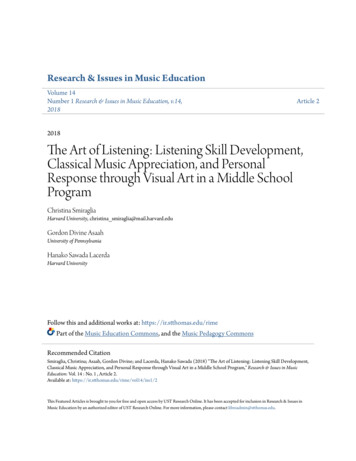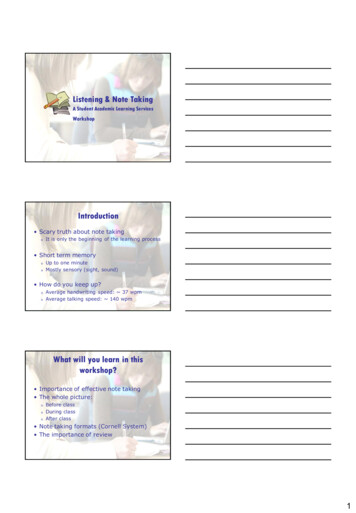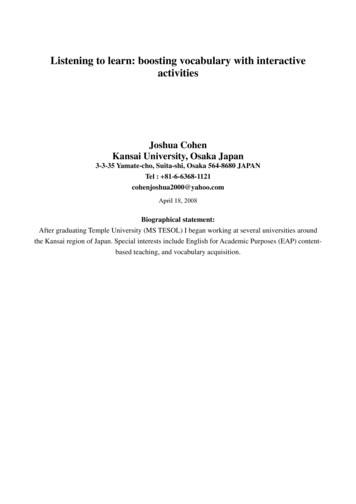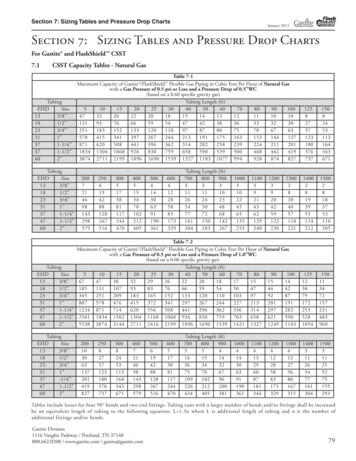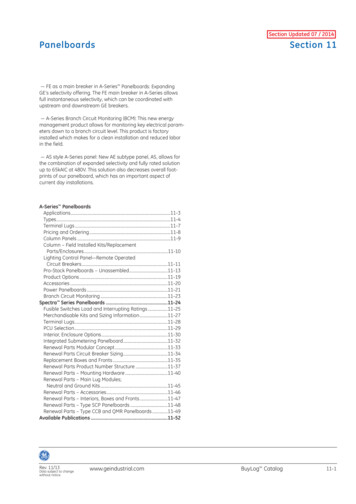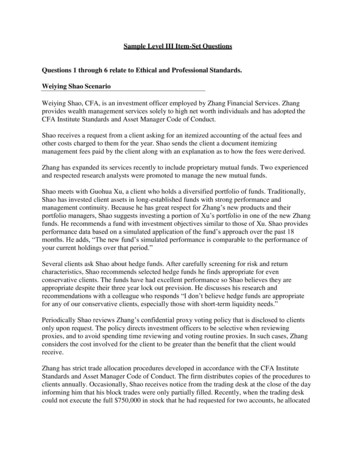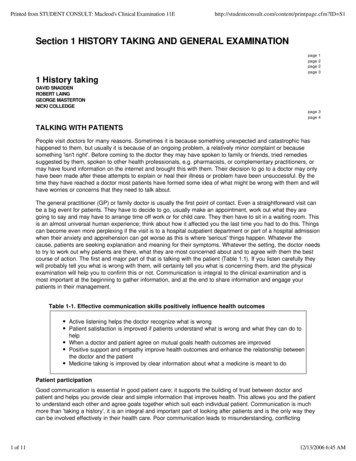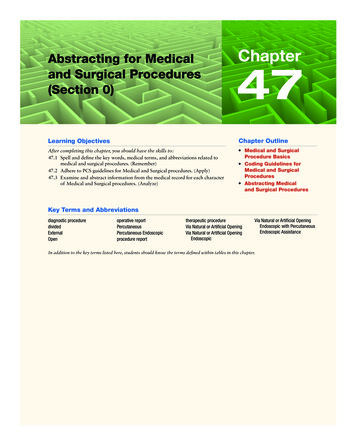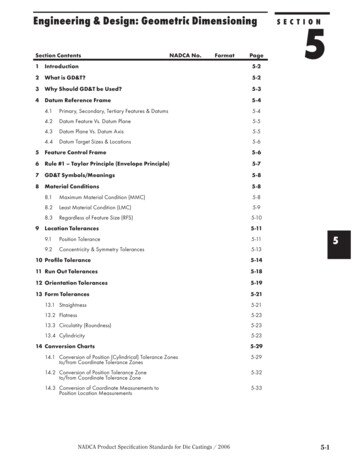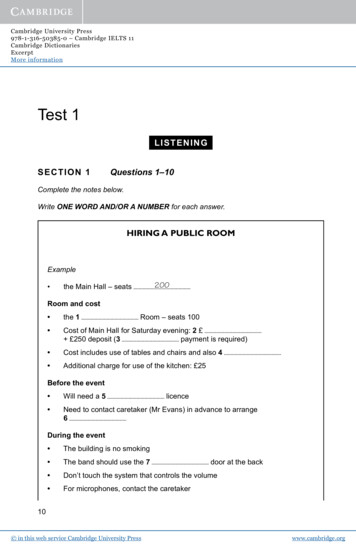
Transcription
Cambridge University Press978-1-316-50385-0 – Cambridge IELTS 11Cambridge DictionariesExcerptMore informationTest 1LIS T E NI NGS E C TION 1Questions 1–10Complete the notes below.Write ONE WORD AND/OR A NUMBER for each answer.HIRING A PUBLIC ROOMExample 200the Main Hall – seatsRoom and cost the 1 Cost of Main Hall for Saturday evening: 2 payment is required) 250 deposit (3 Cost includes use of tables and chairs and also 4 Additional charge for use of the kitchen: 25Room – seats 100Before the event Will need a 5 Need to contact caretaker (Mr Evans) in advance to arrange6licenceDuring the event The building is no smoking The band should use the 7 Don’t touch the system that controls the volume For microphones, contact the caretakerdoor at the back10 in this web service Cambridge University Presswww.cambridge.org
Cambridge University Press978-1-316-50385-0 – Cambridge IELTS 11Cambridge DictionariesExcerptMore informationListeningAfter the event Need to know the 8 The 9must be washed and rubbish placed in black bags All 10must be taken down Chairs and tables must be piled upfor the cleaning cupboard11 in this web service Cambridge University Presswww.cambridge.org
Cambridge University Press978-1-316-50385-0 – Cambridge IELTS 11Cambridge DictionariesExcerptMore informationTest 1S E C TION 2Questions 11–20Questions 11–14Complete the notes below.Write ONE WORD for each answer.Fiddy Working Heritage FarmAdvice about visiting the farmVisitors should take care not to harm any 11 not touch any 12 wear 13 not bring 14into the farm, with certain exceptions12 in this web service Cambridge University Presswww.cambridge.org
Cambridge University Press978-1-316-50385-0 – Cambridge IELTS 11Cambridge DictionariesExcerptMore informationListeningQuestions 15–20Label the map below.Write the correct letter A–I, next to Questions 15–20.ABCDEFGHI15Scarecrow18Black Barn16Maze19Covered picnic area17Café20Fiddy House13 in this web service Cambridge University Presswww.cambridge.org
Cambridge University Press978-1-316-50385-0 – Cambridge IELTS 11Cambridge DictionariesExcerptMore informationTest 1S E C TION 3Questions 21–30Choose the correct letter, A, B or C.Study on Gender in Physics21The students in Akira Miyake’s study were all majoring inABC22The aim of Miyake’s study was to investigateABC23to reduce stressto strengthen verbal abilityto encourage logical thinkingWhat surprised the researchers about the study?ABC27what they enjoyed about studying physics.the successful experiences of other people.something that was important to them personally.What was the aim of the writing exercise done by the subjects?ABC26the teachers marked them in an unfair way.the male students expected them to do badly.their test results were lower than the male students’.Miyake’s team asked the students to write aboutABC25what kind of women choose to study physics.a way of improving women’s performance in physics.whether fewer women than men study physics at college.The female physics students were wrong to believe thatABC24physics.psychology or physics.science, technology, engineering or mathematics.how few students managed to get A gradesthe positive impact it had on physics results for womenthe difference between male and female performanceGreg and Lisa think Miyake’s results could have been affected byABCthe length of the writing task.the number of students who took part.the information the students were given.14 in this web service Cambridge University Presswww.cambridge.org
Cambridge University Press978-1-316-50385-0 – Cambridge IELTS 11Cambridge DictionariesExcerptMore informationListening28Greg and Lisa decide that in their own project, they will compare the effects ofABC29The main finding of Smolinsky’s research was that class teamwork activitiesABC30two different writing tasks.a writing task with an oral task.two different oral tasks.were most effective when done by all-women groups.had no effect on the performance of men or women.improved the results of men more than of women.What will Lisa and Greg do next?ABCtalk to a professorobserve a science classlook at the science timetable15 in this web service Cambridge University Presswww.cambridge.org
Cambridge University Press978-1-316-50385-0 – Cambridge IELTS 11Cambridge DictionariesExcerptMore informationTest 1S E C TION 4Questions 31–40Complete the notes below.Write ONE WORD ONLY for each answer.Ocean BiodiversityBiodiversity hotspots areas containing many different species important for locating targets for 31 at first only identified on landBoris Worm, 2005 identified hotspots for large ocean predators, e.g. sharks found that ocean hotspots:–were not always rich in 32–had higher temperatures at the 33–had sufficient 34in the waterLisa Ballance, 2007 looked for hotspots for marine 35 found these were all located where ocean currents meetCensus of Marine Life found new ocean species living:–under the 36–near volcanoes on the ocean floor16 in this web service Cambridge University Presswww.cambridge.org
Cambridge University Press978-1-316-50385-0 – Cambridge IELTS 11Cambridge DictionariesExcerptMore informationListeningGlobal Marine Species Assessment want to list endangered ocean species, considering:–population size–geographical distribution–rate of 37Aim: to assess 20,000 species and make a distribution 38for each oneRecommendations to retain ocean biodiversity increase the number of ocean reserves establish 39 reduce fishing quotas catch fish only for the purpose of 40corridors (e.g. for turtles)17 in this web service Cambridge University Presswww.cambridge.org
Cambridge University Press978-1-316-50385-0 – Cambridge IELTS 11Cambridge DictionariesExcerptMore informationTest 1R EADI NGR E A D ING P A S S A GE 1You should spend about 20 minutes on Questions 1–13, which are based on ReadingPassage 1 below.Crop-growing skyscrapersBy the year 2050, nearly 80% ofthe Earth’s population will live inurban centres. Applying the mostconservative estimates to currentdemographic trends, the humanpopulation will increase by aboutthree billion people by then. Anestimated 109 hectares of new land(about 20% larger than Brazil) will beneeded to grow enough food to feedthem, if traditional farming methodscontinue as they are practised today.At present, throughout the world,over 80% of the land that is suitablefor raising crops is in use. Historically,some 15% of that has been laid wasteby poor management practices. Whatcan be done to ensure enough foodfor the world’s population to live on?The concept of indoor farming isnot new, since hothouse productionof tomatoes and other produce hasbeen in vogue for some time. Whatis new is the urgent need to scaleup this technology to accommodateanother three billion people. Manybelieve an entirely new approach toindoor farming is required, employingcutting-edge technologies. One suchproposal is for the ‘Vertical Farm’.The concept is of multi-storeybuildings in which food crops aregrown in environmentally controlledconditions. Situated in the heart ofurban centres, they would drasticallyreduce the amount of transportationrequired to bring food to consumers.Vertical farms would need to beefficient, cheap to construct andsafe to operate. If successfullyimplemented, proponents claim,vertical farms offer the promiseof urban renewal, sustainableproduction of a safe and variedfood supply (through year-roundproduction of all crops), and theeventual repair of ecosystems thathave been sacrificed for horizontalfarming.It took humans 10,000 years tolearn how to grow most of the cropswe now take for granted. Along theway, we despoiled most of the landwe worked, often turning verdant,natural ecozones into semi-ariddeserts. Within that same time frame,we evolved into an urban species, inwhich 60% of the human populationnow lives vertically in cities. Thismeans that, for the majority, wehumans have shelter from theelements, yet we subject our food-18 in this web service Cambridge University Presswww.cambridge.org
Cambridge University Press978-1-316-50385-0 – Cambridge IELTS 11Cambridge DictionariesExcerptMore informationReadingbearing plants to the rigours of thegreat outdoors and can do no morethan hope for a good weather year.However, more often than not now,due to a rapidly changing climate,that is not what happens. Massivefloods, long droughts, hurricanes andsevere monsoons take their toll eachyear, destroying millions of tons ofvaluable crops.The supporters of vertical farmingclaim many potential advantages forthe system. For instance, crops wouldbe produced all year round, as theywould be kept in artificially controlled,optimum growing conditions. Therewould be no weather-related cropfailures due to droughts, floods orpests. All the food could be grownorganically, eliminating the need forherbicides, pesticides and fertilisers.The system would greatly reduce theincidence of many infectious diseasesthat are acquired at the agriculturalinterface. Although the system wouldconsume energy, it would returnenergy to the grid via methanegeneration from composting nonedible parts of plants. It would alsodramatically reduce fossil fuel use,by cutting out the need for tractors,ploughs and shipping.A major drawback of vertical farming,however, is that the plants wouldrequire artificial light. Without it,those plants nearest the windowswould be exposed to more sunlightand grow more quickly, reducingthe efficiency of the system. Singlestorey greenhouses have the benefitof natural overhead light: even so,many still need artificial lighting.A multi-storey facility with no naturaloverhead light would require farmore. Generating enough light couldbe prohibitively expensive, unlesscheap, renewable energy is available,and this appears to be rather a futureaspiration than a likelihood for thenear future.One variation on vertical farming thathas been developed is to grow plantsin stacked trays that move on rails.Moving the trays allows the plants toget enough sunlight. This system isalready in operation, and works wellwithin a single-storey greenhousewith light reaching it from above: itis not certain, however, that it can bemade to work without that overheadnatural light.Vertical farming is an attempt toaddress the undoubted problemsthat we face in producing enoughfood for a growing population. At themoment, though, more needs to bedone to reduce the detrimental impactit would have on the environment,particularly as regards the use ofenergy. While it is possible thatmuch of our food will be grown inskyscrapers in future, most expertscurrently believe it is far more likelythat we will simply use the spaceavailable on urban rooftops.19 in this web service Cambridge University Presswww.cambridge.org
Cambridge University Press 978-1-316-50385-0 – Cambridge IELTS 11 Cambridge Dictionaries Excerpt More information in this web service Cambridge University Press .
